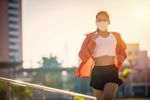The CDC continues urging the public to wear face coverings any time they leave home. Here's what you need to know.
Nearly eight months after the first case of coronavirus was confirmed in the U.S., the virus is still sweeping across the country. While New York State has brought its positive test rate down to about 1 percent, many other states are seeing their highest totals of infections yet.
While preventing transmission of the virus cannot be guaranteed entirely, research across the board points to the same conclusion: Wearing face masks, along with social distancing and washing hands, are currently the best techniques for preventing the spread of COVID-19.
The CDC urges everyone to wear face masks when in public or around people not in your household. Research continues to prove that the virus is most commonly spread through aerosolized droplets — not only from a cough or sneeze, but from someone talking or breathing — and can float in the air for up to three hours.
RELATED: Clear Answers to Confusing COVID-19 Questions
In addition, much of the spread comes specifically from asymptomatic and pre-symptomatic cases, meaning everyone you come in contact with has the potential to be a carrier. And you have the potential of being one of those carriers too. Knowing who is or is not infected just by looking is not possible, which is why preventative protocol is of the utmost importance.
"Projections estimate 33,000 deaths could be avoided by October 1 if 95 percent of people wear masks in public."
Ideally, everyone would wear a mask. But as epidemiologist and UCSF Professor George Rutherford, MD, said in a recent interview, “What you want is 100 percent of people to wear masks, but you’ll settle for 80 percent.” The good news: One simulation predicted that 80 percent of the population wearing masks would do more to reduce COVID-19 spread than a strict lockdown, while other projections estimate that 33,000 deaths could be avoided by October 1 if 95 percent of people wear masks in public.
Even in high-risk scenarios, reports have indicated that masks can prevent transmission. Take this story for example: A man flew from China to Toronto where he then tested positive for COVID-19. He wore a mask on the flight and the 25 people closest to him all tested negative for the disease.
What Masks Work Best?
Infectious disease specialist Peter Chin-Hong, MD, told the University of California San Francisco that the best mask is one you can wear comfortably and consistently. When a mask is uncomfortable, you are more inclined to adjust it or touch it while out in public, which impedes (or even negates) its efficacy. Since it’s no longer a matter of if you should wear one, focus on how to make your mask comfortable and effective.
N95 masks were initially touted as the most effective; however, experts have advised against wearing them due to the one-way valve that protects the wearer, but not those around them. The valve closes when the wearer breathes in and opens when the wearer breathes out, allowing for spread if the wearer is infected.
As many have already done, you can fashion a fabric mask yourself using materials you already have on hand. The main criteria is that it covers your nose and mouth. Masks also protect you when you inadvertently touch your nose and mouth (which experts say we do reflexively hundreds of times a day) after being in contact with a surface that may be contaminated.
What counts as a face mask? Ski gators, handkerchiefs, bandanas and even scarves work — though they should be reserved as a last resort because they can slip or be made from porous material.
Prefer to buy, rather than DIY? Our new Movement Mask is machine-washable, reusable and contains an antimicrobial agent to help control odors, making it the perfect option to wear while exercising or simply running errands.
How to Properly Use a Mask:
- Wash hands with soap and water or alcohol-based hand sanitizer (at least 60% alcohol) before putting the mask on and after removing it.
- Double check that the mask covers your nose and mouth completely, ideally with a tight fit.
- Make any adjustments to the mask before you go outside.
- Do not adjust it after you leave your home and avoid touching it while wearing it in case your hands become contaminated.
- Take it off by the elastic ear bands and do not touch the front of the mask.
- Wash or dispose of mask immediately after using it.
What About Gloves?
Disposable gloves may provide an extra barrier between your hands and contaminated surfaces — however, experts still say that the best way to keep your hands clean is by washing them with soap and water or an alcohol-based hand sanitizer (at least 60 percent alcohol).
Also, contamination during glove removal is common, the CDC warns. So if you do choose to wear them, make sure to clean your hands after removing your gloves. Plastic surgeon Dr. Paul Nassif filmed an IGTV tutorial on how to properly remove gloves.




